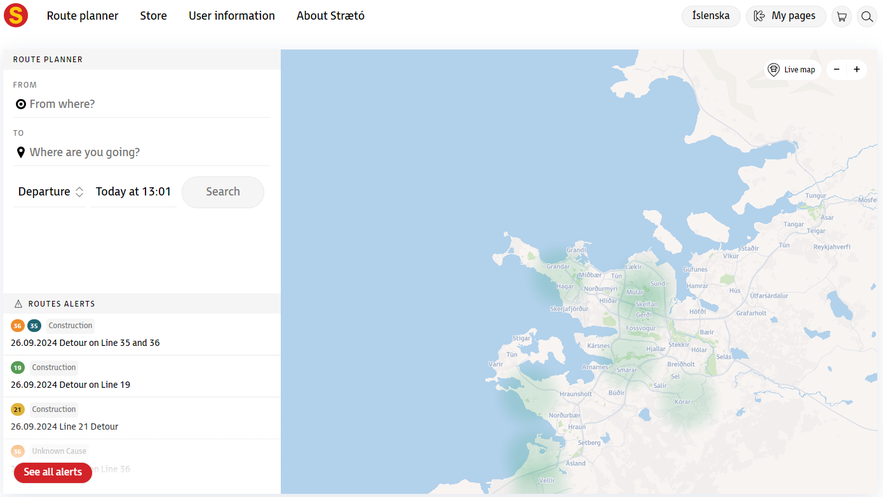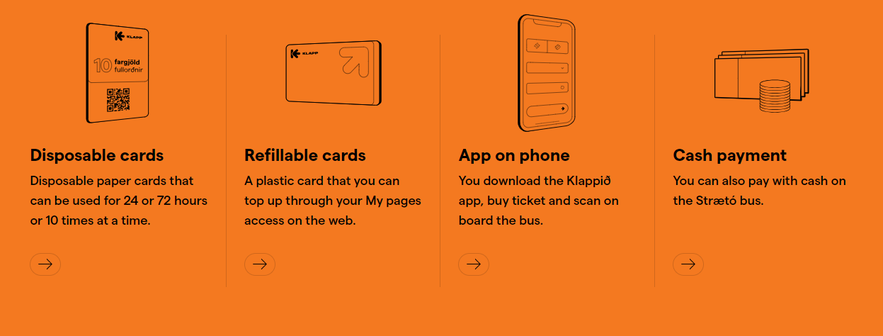
Reykjavik City Buses: The Ultimate Guide
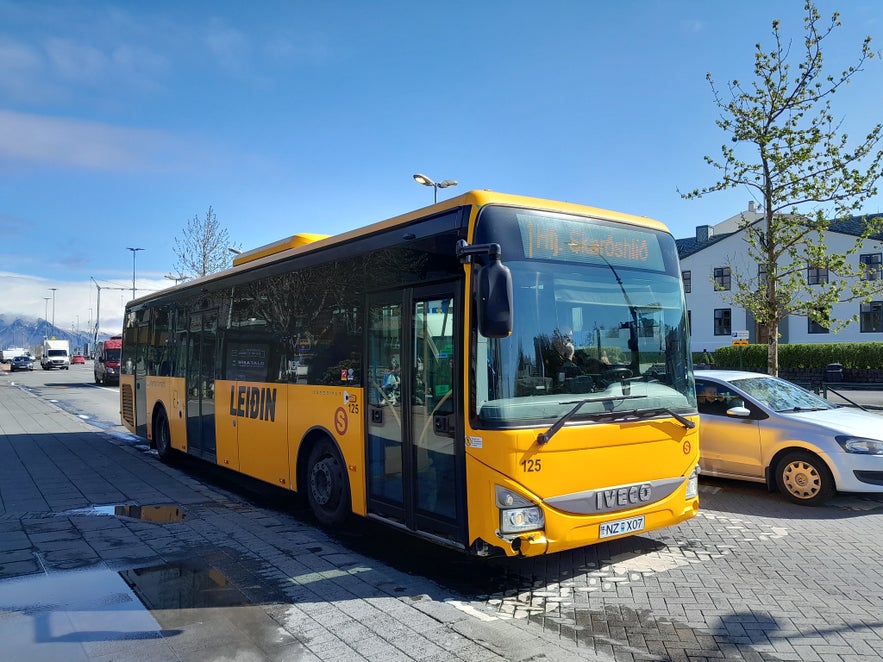
Getting to know public transport in an unfamiliar city can be tricky, so how does it work in Reykjavik? What transport options are there, and how do you pay? How do you know which bus to take? Read on to discover all about public transportation in Reykjavik!
The only form of public transportation in Reykjavik is the Straeto bus system, which is the primary way to get around the city without a rental car. These city buses are easily recognizable due to their cheerful yellow color, and you'll find convenient bus stops close to Reykjavik accommodations and popular attractions.
The name "Straeto" is short for "Strætisvagn," which translates to "Street Wagon," and has become so ingrained in Icelandic culture that Icelanders often refer to buses abroad using the same term. This network includes 36 routes within the capital region. You can also take buses around the countryside, though these routes have different prices and time schedules than the Reykjavik buses.
While you can get to specific locations in the countryside by public bus, you won't have much freedom to explore once you reach your destination unless you continue the journey on foot or by bike. Therefore, it's best to book guided tours or day trips from Reykjavik if you want to see Iceland's iconic nature but don't have a rental car.
Below, you can find all the practical information you need about how you can use the Reykjavik public bus system, how to get bus tickets, and more!
- Riding the bus is a great way to do Sightseeing in Reykjavik
- Discover the Secret Spots & Hidden Gems in Reykjavik
- Prefer to drive yourself? Here is The Ultimate Guide to Driving in Iceland
Photo above from Flickr, by 7beachbum. No edits made.
When Can I Get the Bus in Reykjavík?
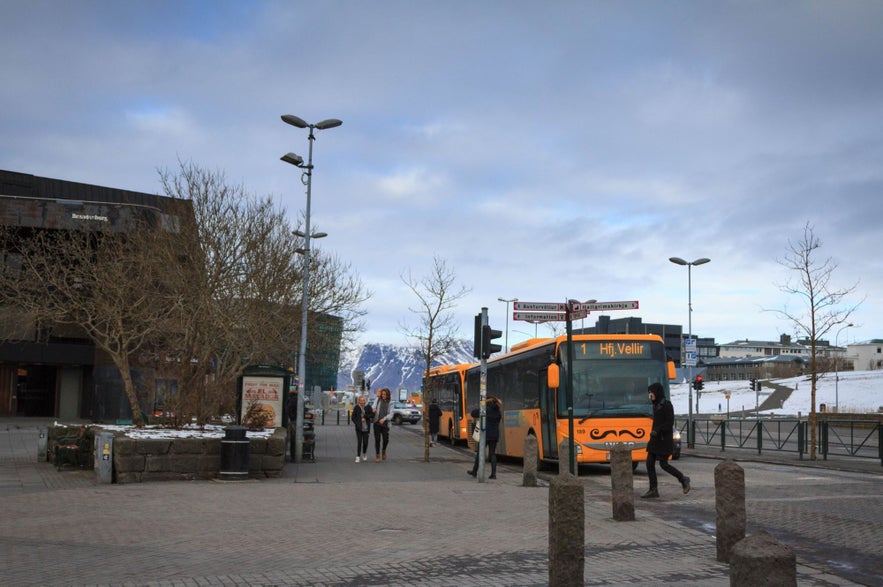 Photo from Wikimedia, Creative Commons, by Gary J. Wood. The bus stop by Laekjartorg square in downtown Reykjavik.
Photo from Wikimedia, Creative Commons, by Gary J. Wood. The bus stop by Laekjartorg square in downtown Reykjavik.
The buses in Reykjavik start running around 6:30 on weekdays, 7:30 on Saturdays, and 9:30 on Sundays and public holidays. Most routes stop running shortly before or just after midnight, with the exception of the night bus routes which run on Fridays and Saturdays, more information on the night buses can be found later in this article.
To find out which bus you need to catch you can use the Straeto website’s handy bus route planner, which is also available in the "Klappid" Straeto app. You can also see the live location of all buses and see the timetables for each bus route.
The Reykjavik bus route planner on the Straeto website.
To use the route planner, you simply have to input the location you’ll be departing from, your destination, and your preferred time of departure or arrival. The route planner will then show you several options to reach your destination.
The timetables show what time of day the buses stop at specific locations. Detailed information on individual schedules can be seen at each bus stop and searched on the Straeto website.
Most routes have buses running at least every half-hour. Journeys are more frequent during peak hours, which are between 7-9 AM and 3-6 PM on weekdays, with the main buses departing every 15 minutes.
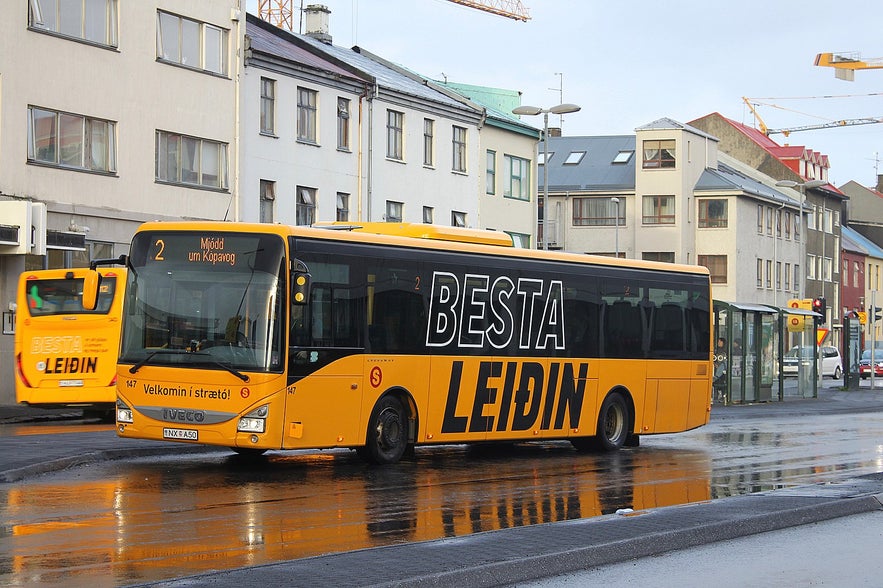 Photo from Wikimedia, Creative Commons, by NAC. No edits made.
Photo from Wikimedia, Creative Commons, by NAC. No edits made.
Routes 1 and 6 have more journeys than other routes, on a normal weekday those buses depart every 10 minutes during peak times, every 15 minutes the rest of the day and every half hour in the evening.
On public holidays, the buses operate on a Sunday schedule. The following days of the year also have unusual operating hours; On January 1st and December 25th, the buses that drive from Reykjavik to the countryside don’t run. On December 24th and December 31st, the buses stop running at 3 PM.
Where Can I Get the Bus in Reykjavik?
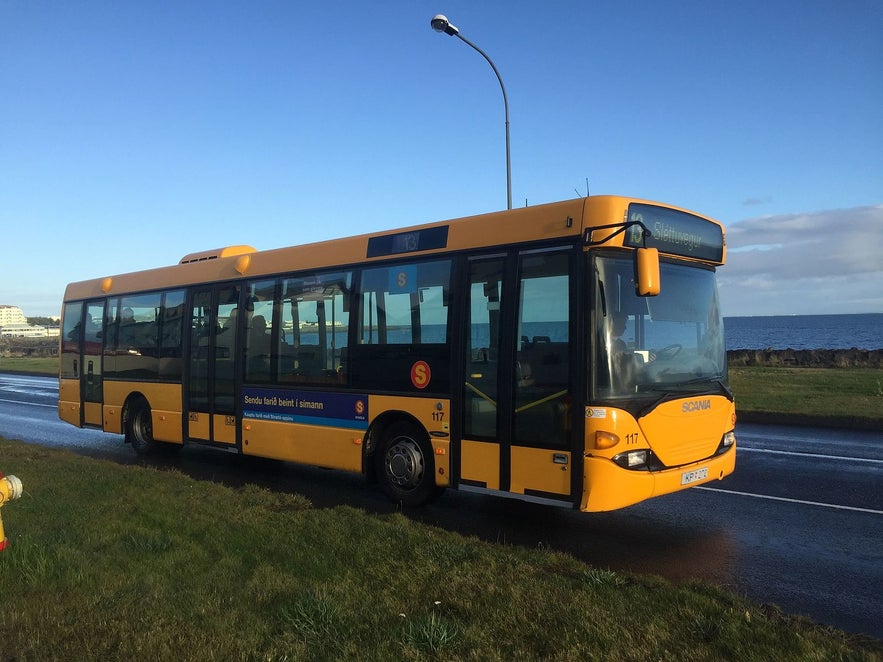 Photo from Wikimedia, Creative Commons, by Richard Eriksson. No edits made
Photo from Wikimedia, Creative Commons, by Richard Eriksson. No edits made
Straeto bus stops are easy to identify. They are all marked with the Straeto BS logo, a red circle with a yellow S. Some bus stops are only a pole with the logo on top and timetables attached, others have a shelter for you to wait for the bus in.
To find out where the nearest bus stop is, you can search on the website or check the live map in the Straeto app, which also allows you to track the location of all buses.
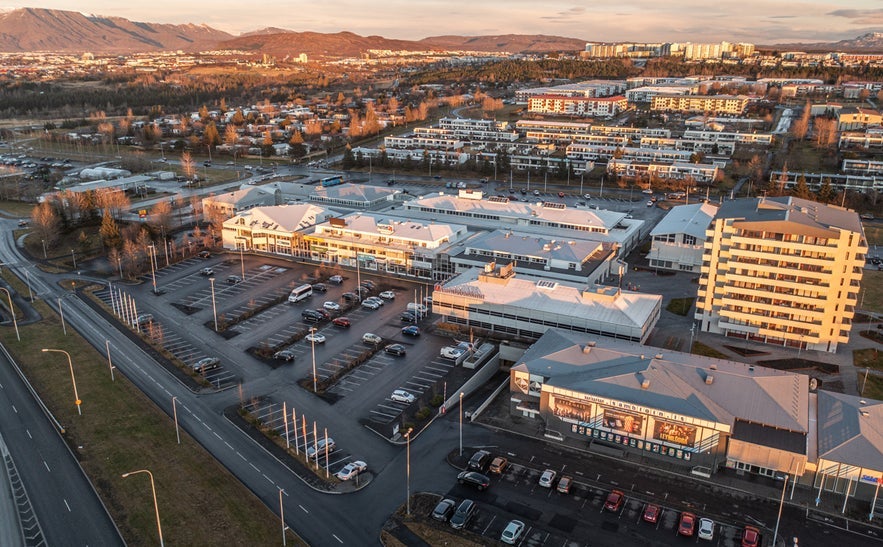
Photo from Mjodd website. No edits made. The Mjodd service center connects many Reykjavik bus lines.
It’s not guaranteed that one bus will get you where you need to go, you might have to switch between buses. There are several bus stops in the capital region that are specifically designed to connect routes from across the bus network for easy transfer.
These stops are Fjordur, Asgardur, Hamraborg, Mjodd and Artun. The journeys are strategically planned so that buses arrive simultaneously to make switching buses easy for commuters.
The bus stops Hlemmur, Spongin, and Haholt are also connection stops, but waiting times might be longer there since their timetables aren’t specifically designed to make transfers smoother.
The stop which connects the city buses and the buses heading outside the capital region is Mjodd, in the Breidholt neighborhood in Reykjavik.
- Discover the Top 14 Things to Do in Reykjavik
How Do I Pay For the Bus in Reykjavik?
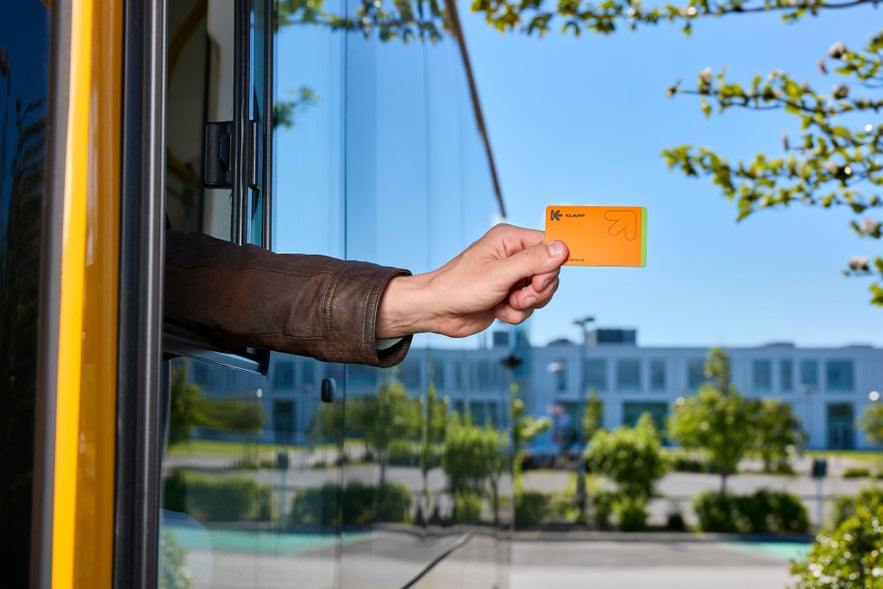 Photo from Straeto. The Klappid bus card.
Photo from Straeto. The Klappid bus card.
There are four ways to pay for the bus in Reykjavik: Cash, a reusable or paper Klappid bus card, or the Klappid App.
You can pay the bus fare in cash as each bus has a fare collecting box next to the driver. Be aware that you can't get the change back, so make sure to have the exact correct amount or be ready to overpay. If you choose to pay in cash, you will get one exchange ticket per person from the driver that's valid for 75 minutes. This means that you don't need to pay again if you need to switch to another bus within that time frame. Instead, you show the exchange ticket to the driver on entry.
Klappid payment methods.
A physical Klappid card can be bought at various Klappid vendors throughout the city. You can either get a plastic bus card that can be topped up throughout your visit by connecting it to the Klappid app or go for a paper card that lasts for either 24 hours or 72 hours or can be used 10 times. You can then check the balance of your 10-trip card online.
You can also use a bus smart card to ride the bus. These cards are in the Klappid app and are the best option for those staying in Reykjavik for a longer stretch of time. You can buy a card that lasts for 24 hours, 72 hours, 30 days, or for a whole year. You open them on your smartphone and scan them when entering the bus to verify the ticket.
How Much Does a Reykjavik Bus Ticket Cost?
As of fall 2024, the fare for one adult is 650 ISK. For pensioners and children aged 6-17, the fare is 325 ISK. For those with a disability, you can get the bus fare for 195 ISK, but only by purchasing through the Klappid app. Children under six years old don’t have to pay to ride the bus.
To check the current price of fares, check out the Straeto price list on their website.
- Check out: How to Travel Around Iceland Without a Car
- See also: Where to Eat in Reykjavik: 12 Spots for Dining on a Budget
How Do I Use the Klappid App?

Photo from Straeto. The Hamraborg bus stop by the Library of Kopavogur, where you can get physical Klappid bus cards.
The Klappid app is available in the App Store for Apple devices and on Google Play for Android devices. It can be set to either Icelandic or English. Be aware that you need an internet connection to buy and use tickets from the app. Most buses in Reykjavik have free wifi, but it’s better to purchase tickets beforehand and not rely on the bus wifi.
The Klappid app is a convenient way to use public transport in Iceland. The app allows you to buy tickets, plan routes, and view real-time updates of your bus’ location.
To use the app, you simply download it, register with your phone number and card details (the app does not accept American Express), purchase a ticket or card, and you can start riding the bus.
When you buy a ticket, it isn’t automatically activated, so you can buy tickets and save them for later. They will remain available under the "My Tickets" section in the app. Once activated, a single-fare ticket is valid for 75 minutes.
When you enter the bus, have your ticket or card ready to be scanned. To your right, you'll see a screen where you can scan the QR code of your ticket. The screen will then turn green when it's accepted, and you can go find your seat!
Can I Use Public Transport At Night In Reykjavik?

Straeto runs a very limited night bus service late on the nights before Saturday and Sunday when Reykjavik’s vibrant nightlife is at its height. These are mostly useful if you're staying somewhere outside Reykjavik but well worth keeping in mind.
There are five routes: 101, 103, 104, 105, and 106. Each one has three departure times between 1:20 AM and 3:45 AM, different for each route.
These night bus routes start at either Laekjatorg square or Laugavegur street and go to different areas of the capital region. No buses run towards the city center after midnight.
The night buses don't make any scheduled stops, so if you're planning to catch these buses in a different location than their starting points, make sure to watch the live timing in the Klappid app and wave to the driver when you see the bus approaching.
You can find more details about the night bus schedule on the Straeto website. The night bus fare is 1260 ISK (as of fall 2024). You can pay with cash or with a special night bus ticket in the Klappid app. If you have a 30-day or one-year card, it's also valid.
- Check out the Reykjavik Nightlife Guide
- Also, discover the Best Bars in Reykjavik: The Ultimate Guide
Reykjavik Bus Etiquette
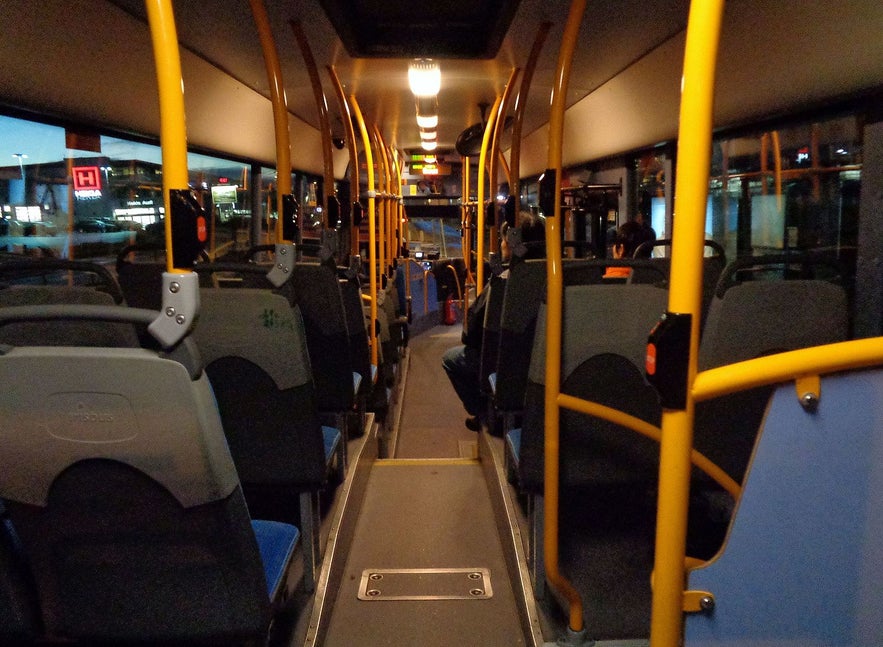 Photo from Wikimedia, Creative Commons, by Otto Karikoski
Photo from Wikimedia, Creative Commons, by Otto Karikoski
You can only get on and off the Straeto bus at designated stops. Make sure to stand outside the bus stop and be ready to go as soon as you see the bus, clearly indicating your intention to board. You can also stick your hand out to flag down the bus if you want to be sure. If you're not paying attention or are still inside the bus shelter, the driver may think you're not going to board and simply drive past you.
If a bus displays the text "Er ekki á leið" it means the bus is not in service.
Unless you have a bicycle, a baby carriage, are in a wheelchair, or have another reason to enter at the middle of the bus, you should always enter through the front doors. You should have your payment ready before boarding the bus.
You are not allowed to exit at the front of the bus, instead use one of the two rear doors. Iceland can be very slippery so take care when stepping off the bus.
You are allowed to bring bicycles and suitcases on the bus but know that wheelchairs and baby prams are prioritized in the open designated area in the middle of the bus.
There is space for one wheelchair on each bus and there is a foldable ramp by the middle exit. If you're a wheelchair user, know that drivers only assist with opening and closing the ramp itself, but you'll have to secure your chair yourself or have someone with you who can help.
- See also: What to do With Young Kids in Reykjavik
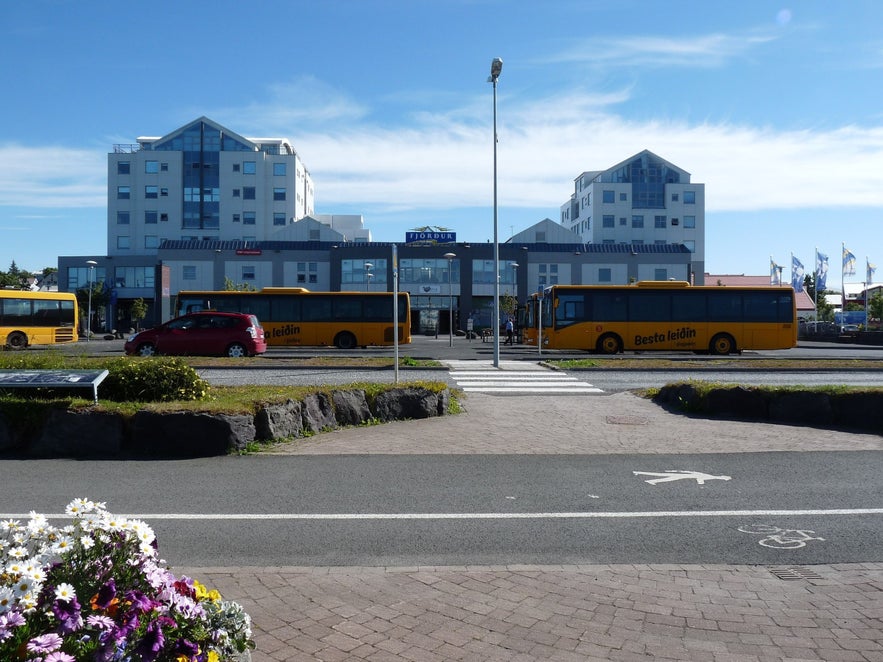
Photo from Wikimedia, Creative Commons, by Smiley.toerist.
Please note that although many do, drivers are not required to speak English and might not be able to provide you with detailed information. It's best to use the route planner and online resources to find the information you need before your journey.
Scooters, rollerblades, and skateboards must be carried if you bring them on the bus, and, unsurprisingly, they cannot be used during the ride.
Pets are allowed on city buses under the following conditions. Pets have to get on the bus through the back sets of doors and stay at the back while they ride the bus. The pet’s caretaker must be over 18 years of age to be allowed to bring the pet on the bus and each person is only allowed to bring one pet. Dogs must be on a lead, other pets must be secured in a cage.
Pets are allowed on the bus except during the busiest times of day, so on weekdays, between 7 and 9 AM and 3 and 6 PM. Trained guide dogs are exempt from these rules and are always allowed.
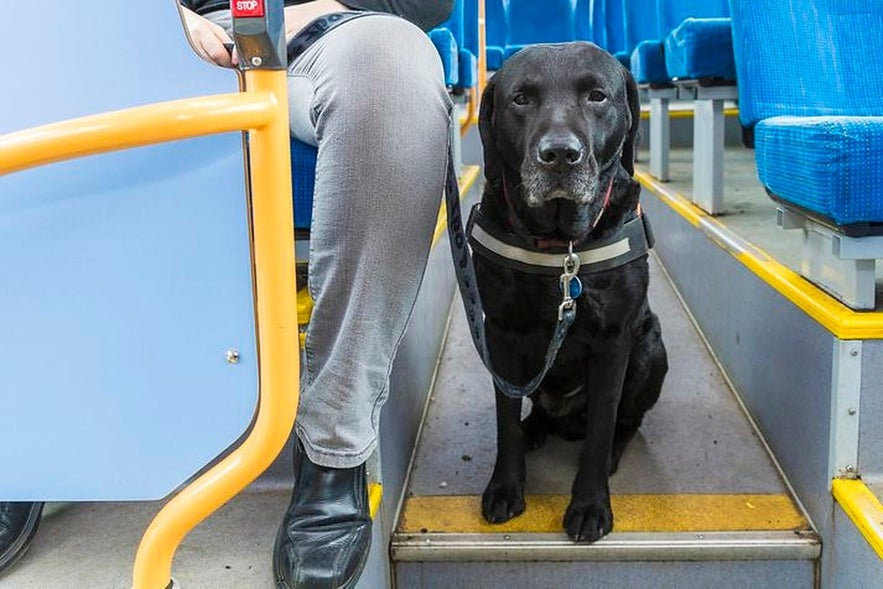
Photo from Straeto/visit.is.
Be mindful of other passengers; there are priority seats for those less able to stand; if you sit in one of those, be ready to offer it to someone who needs it more. Please note that Icelanders are usually quiet on the bus (unless you happen to encounter a group of pre-school children on a field trip). Do not disturb the peace by playing music without headphones on the bus. If you're having a phone call on the bus, do not use the speakers on your phone, and try to speak in a quiet manner.
You are not allowed to eat or smoke on the bus in Reykjavik.
- Learn about the 10 Weirdest Things About Icelandic People and Culture
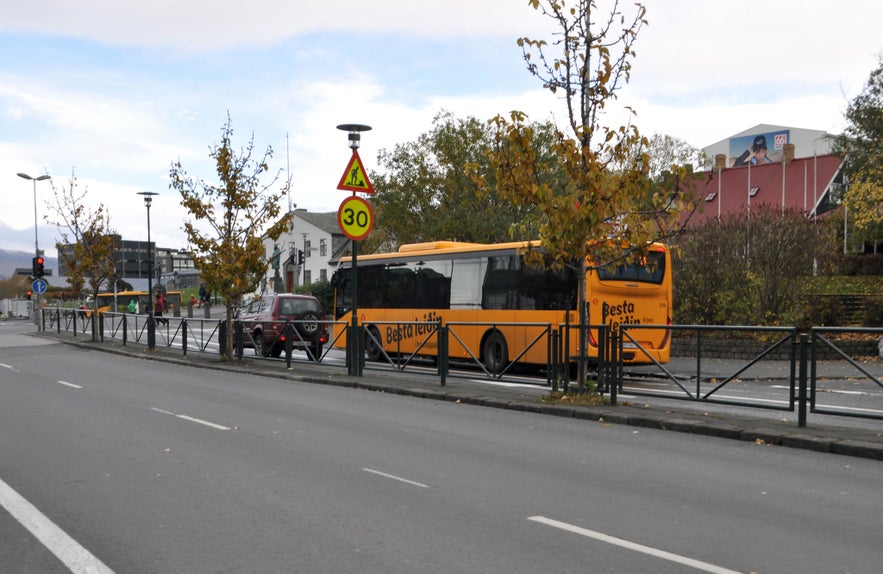
Photo from Flickr, by BeyondDC.
We hope this article answered your questions about Reykjavík public transport. It's a convenient way to get around Reykjavik and travel in a more eco-friendly way. Enjoy whizzing around the city in the iconic yellow Straeto buses!
Do you have any questions about the Icelandic transport system? Will you use public transport during your visit to Iceland? Have you visited Iceland before? Share your thoughts and experience in the comment section below!
Other interesting articles
Graffiti and Street Art in Reykjavík
Despite being the world's northernmost capital, Reykjavík is home to a thriving and prevalent street art scene. Where did it all begin and where does it go from here? Learn about Iceland's graffiti...Read more
Best Restaurants in Iceland Open During Christmas & New Year's 2024
Find out which restaurants are open for Christmas and New Year's 2024 in Reykjavik and plan your holiday season meals. While some restaurants close during the holidays, some stay open during this ti...Read moreThe Best Cafés in Reykjavik & Icelandic Coffee Culture
Where can you find the best coffee in Reykjavik? How much coffee does the average Icelander drink a year, and what is unique about coffee culture in Iceland? Read on to learn everything you need to...Read more

Download Iceland’s biggest travel marketplace to your phone to manage your entire trip in one place
Scan this QR code with your phone camera and press the link that appears to add Iceland’s biggest travel marketplace into your pocket. Enter your phone number or email address to receive an SMS or email with the download link.

